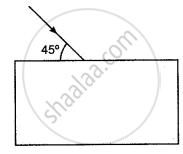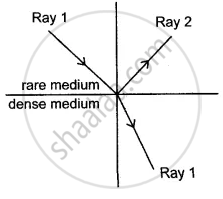Advertisements
Advertisements
प्रश्न
A student traces the path of a ray of light through a rectangular glass slab for the different values of angle of incidence. He observes all possible precautions at each step of the experiment. At the end of the experiment, on analyzing the measurements, which of the following conclusions is he likely to draw?
(A) ∠i = ∠e < ∠r
(B) ∠i < ∠e < ∠r
(C) ∠i > ∠e > ∠r
(D) ∠i = ∠e > ∠r
उत्तर
(A) ∠ i = ∠ e < ∠ r
In refraction through a rectangular slab, the angle of incidence is equal to the angle of emergence. Also, the angle of refraction should be smaller than the angle of incidence.
APPEARS IN
संबंधित प्रश्न
Draw the diagram given below and clearly show the path taken by the emergent ray.

Write the relation between the angle of incidence and the angle of refraction for a medium.
The highest refractive index is of ______.
How is the angle of emergence related to the angle of incidence when prism is in the position of minimum deviation? Illustrate your answer with help of a labelled diagram using an equilateral prism?
How does the deviation produced by a prism depend on the wavelength of incident light?
Does the depth of a tank of water appear to change or remain the same when viewed normally from above?
A ray of light moves from a rare medium to a dense medium as shown in the diagram below. Write down the number of the ray which represents the partially reflected ray.

A ray of monochromatic light is incident from the air on a glass slab:
(i) Draw a labelled ray diagram showing the change in the path of the ray till it emerges from the glass slab.
(ii) Name the two rays that are parallel to each other.
(iii) Mark the lateral displacement in your diagram.
A glass block is having refractive index 3/2, the light ray is incident at an angle 45°. Find the sine of the angle of, refraction inside the glass block.
